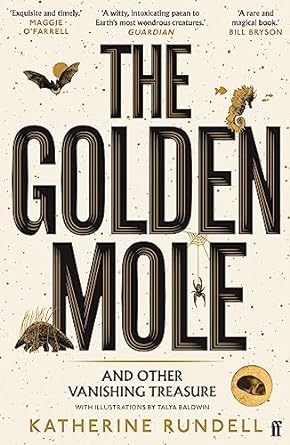Described as ‘part cabinet of wonders, part call to arms’ (Mark Haddon), this month’s read was The Golden Mole by Katherine Rundell.

What do the giraffe, the swift, the wombat, the hare and the seahorse all have in common? They are just some of the endangered stars in Katherine Rundell’s entrancing non fiction essay, The Golden Mole, which comes complete with beautiful illustrations. A whistlestop tour of some of the most amazing and underappreciated creatures in the world, this book both delights (who knew that the wombat had cube shaped poo?) and depresses (most species of seahorse may be dead by 2025 due to rising sea temperatures).
Our readers described it as a book to dip in and out of, with its random facts – and what historically were thought to be facts – proving a popular combination with most of the group. Pliny’s description of the hedgehog preparing for winter by rolling on fallen apples to attach them to their spikes was particularly visual and definitely reminded more than one of the group of the 70s/80s birthday party hedgehog with its pineapple and cheese spines.
Katherine Rundell is also a novelist, her fantasy tale Impossible Creatures was read by two of the group read earlier this year. In The Golden Mole, her approach of combining folklore, natural history, mythology and legend made this an enjoyable read for some, while others felt the sudden jumps between facts and stories made the book neither one thing nor another, and that it didn’t really grab their attention. Others liked the way that the author was trying to instil the sense of awe and wonder, even though they felt that she wasn’t quite succeeding.
The fascinating details of different creatures contrasted with the underlying refrain of how we humans have destroyed – and are continuing to destroy – the planet. The descriptions of how animal populations have drastically decreased made for sad reading, and some of the group queried the juxtaposition of random trivia that might turn up in a pub quiz. For example, in Atlanta, Georgia, it is illegal to tie your giraffe to a streetlamp. While extinction is never a light subject, if this book had just had the facts and statistics, we felt that it would not have been such an interesting read, and would not inspire people to action.
Speaking of action, the author did suggest a few ways in which readers could fight the extinction crisis, but these were the usual methods: protest, eat less meat, don’t fly. One member thought this would have been a good opportunity for the writer to suggest how to foster biodiversity on a local level, such as if you had a garden.
In her section on the pangolin, Rundell describes government billboards asking people not to traffic wildlife, although the high poverty rate makes it a viable way of earning a living. In fact one reader described the book as an extended billboard. On the whole, we didn’t feel that it was a book that would change someone’s mind, as it would probably only be read by people already were concerned. As one reader commented, it isn’t as though people intend to destroy the planet, but they need to earn a living, and quite often this ends up being at the environment’s expense.
Our book choice for next month is BP Walter’s gripping tale The Woman on the Pier.
Screenwriter Caroline Byrne is desperate to know why her daughter was murdered in Stratford when she was meant to be at a friend’s in Somerset. When Caroline discovers the messages Jessica had been sending a boy named Michael, she realises it’s because of him. He failed to meet her that day. He’s the reason her daughter is dead. So she makes a choice. He’s going to pay.
Two strangers meet on the pier. Only one walks away…
Join us on Teams to what we thought of this thriller at 1pm on Wednesday 16th October. Copies of the book are now available from the library, so pop in to get your copy. If you don’t fancy this month’s read, why not pop along to the group anyway and tell us about something you’ve read and loved? We looked forward to seeing you!

